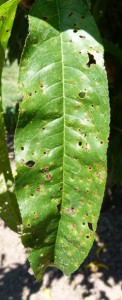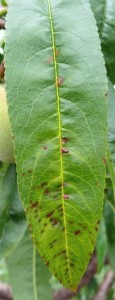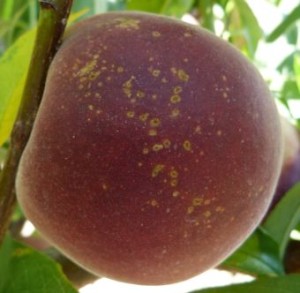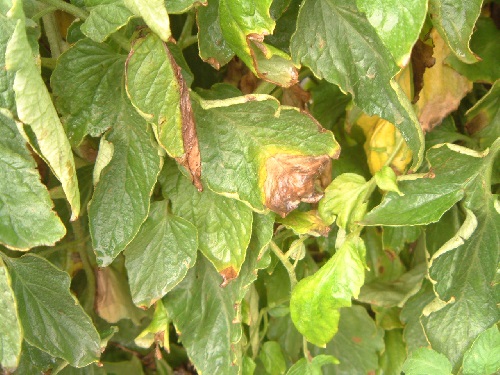It’s Easy To Misdiagnose Bacterial Spot On Peaches
Bacterial spot is a major disease for peach and nectarine growing areas experiencing warm, wet springs and summers. Effective management requires a diverse toolbox to combat the disease from shuck split through cover sprays. One such tool is the use of copper. But problems can result.
Copper works very well keeping fruit clean of bacterial spot and does not cause fruit damage, like fruit russeting observed on apples when copper is used post dormancy.
Although the fruit are durable to copper, the leaves of stone fruit are very sensitive to copper injury. Unfortunately, there can be confusion telling the difference between bacterial spot disease and copper injury on leaves.
How Copper Works
 When using copper, it is important to understand how it works to control pathogens to appreciate how it can cause damage to plant tissue. Copper is a general biocide, which means copper ions will kill fungi, bacteria, and plant tissue.
When using copper, it is important to understand how it works to control pathogens to appreciate how it can cause damage to plant tissue. Copper is a general biocide, which means copper ions will kill fungi, bacteria, and plant tissue.
Two types of copper are available to growers: fixed coppers and bluestone coppers. Fixed copper is safer for plant tissue than “bluestone” copper because it is insoluble in water. Since fixed coppers have low solubility in water, there is a lower risk for injury and may be used throughout the growing season.
When fixed copper is sprayed onto leaves, the copper particles will persist on the plant surface after the spray dries. Each time the plant surface becomes wet, copper ions will be released gradually from copper deposits.
Residual protection against plant pathogens occurs as a result of the gradual release of copper ions from the copper deposits. Copper sprays act as a protectant by killing pathogens that are on the surface of plant tissues, but cannot affect the pathogen once it enters the tissue.
Copper accumulation can increase on plant tissue when sprayed repeatedly. As a result, foliar injury on the oldest leaves is normal and expected when using repeated copper applications as it indicates the copper is working to control the bacterial spot pathogen. However, excessive injury can occur when the copper becomes more soluble, such as during slow drying (rainy) conditions and when applied in an acidic solution.
Higher solubility means there is no gradual release of the copper ions. When this occurs, all of the copper ions are available at the same time when applied, thereby blasting the leaf tissue with the maximum amount of biocide power copper can give. Common forms of fixed coppers include Cuprofix, Kocide, Champ, C-O-C-S WDG, Badge, Nordox 75 WG, and Cueva.
In contrast to fixed coppers, bluestone (copper sulfate pentahydrate) is highly soluble and copper ions can damage exposed plant tissue. Bluestone is often combined with lime to help “tie up” copper ions and slow their release (e.g. Bordeaux mixture). There is no residual activity of bluestone such that copper ions are released rapidly upon application. Bluestone is often used as a dormant spray when minimal amount of green tissue is exposed. Common brands of bluestone include MasterCop and Phyton.
Bacterial Spot Leaf Symptoms
 Bacterial spot symptoms are always angular lesions and this is due to the lesion being bordered by the leaf’s veins. The angular lesions are typically small; however, they can coalesce to form larger lesions. Often times, you will see lesions along the midrib of the leaf, the tip of the leaf, and along the edges. It does not take many lesions on the leaf for the leaf to turn yellow or to fall off. Lesions can occur on older and younger leaves.
Bacterial spot symptoms are always angular lesions and this is due to the lesion being bordered by the leaf’s veins. The angular lesions are typically small; however, they can coalesce to form larger lesions. Often times, you will see lesions along the midrib of the leaf, the tip of the leaf, and along the edges. It does not take many lesions on the leaf for the leaf to turn yellow or to fall off. Lesions can occur on older and younger leaves.
Unlike bacterial spot, copper injury is indicative of a lot of round, circular lesions of variable sizes on the leaf. The reason there are a lot of lesions is due to the spray pattern that occurs on the leaf: every droplet of water most likely contains copper particles. The pattern of the lesions is random, as opposed to following the veins like bacterial spot. The appearance of the leaves is reminiscent of “Swiss cheese.”
As a result of repeated copper sprays, the damage will often result in premature defoliation of older leaves due to higher amounts of residual copper. In contrast, younger leaves will typically look “much healthier” than older leaves since they have less residual copper. Severe premature defoliation will cause tree stress and small fruit size.
Minimizing Copper Injury
The rate listed for coppers labeled for bacterial spot control is too high for a multiple cover spray program. To use copper safely in a bacterial spot management program, Norman Lalancette of Rutgers University recommends using copper at 0.5 oz. copper/acre rate.
 Research trials during summer 2015 at Penn State University and Virginia Tech determined bacterial based bactericides, such as Serenade Optimum (Bayer CropScience) and Double Nickel (Certis), do not minimize the damaging effects of copper when tank mixed. However, lime can be added to reduce the potential for plant damage.
Research trials during summer 2015 at Penn State University and Virginia Tech determined bacterial based bactericides, such as Serenade Optimum (Bayer CropScience) and Double Nickel (Certis), do not minimize the damaging effects of copper when tank mixed. However, lime can be added to reduce the potential for plant damage.
Be mindful of captan and sulfur, which are applied to control fungal diseases. These products will also cause damage to plant tissue similar to copper injury. In addition, products that make tank mixes more acidic, such as adjuvants, phosphonate fungicide and fertilizer products, and mancozeb should be avoided when using copper.
Unfortunately, the weather conditions that favor copper injury also have the potential to favor a bacterial spot explosion. If there is a forecast where it is warm and will rain every other day for three weeks, it is best to minimize your use of copper to manage bacterial spot. During such wet conditions, use oxytetracycline on peaches and nectarines (as long as the harvest is not within the 21-day PHI to keep the bacterial population in check to minimize fruit infection. ●









